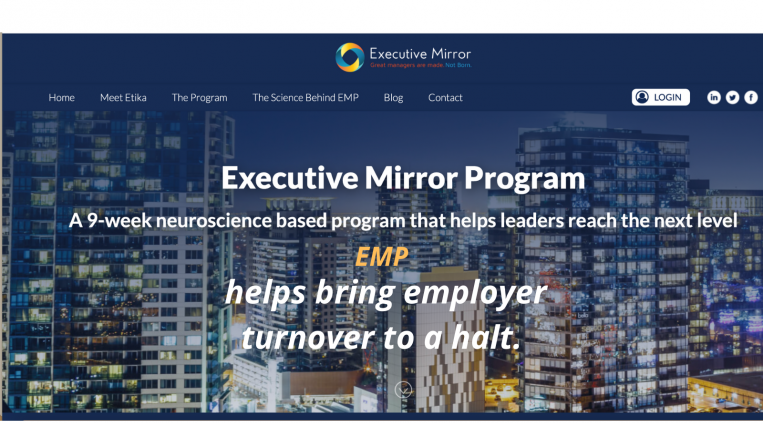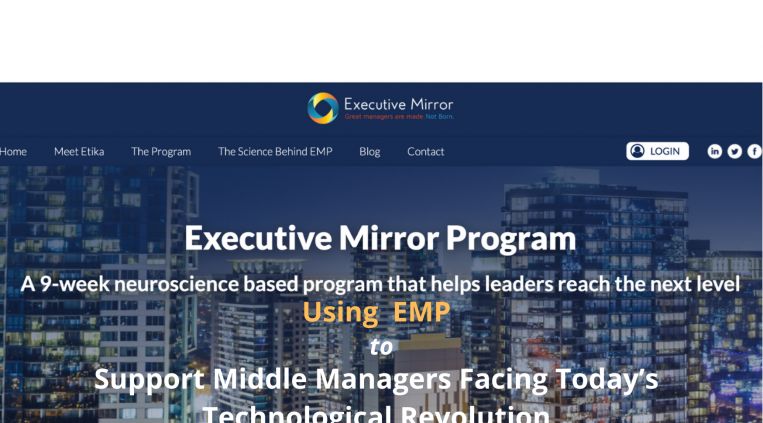
Reversing today’s dizzying employee turnover

According to the U.S. Department of Labor, over 11 million people quit their jobs last quarter - and about 50% of workers are actively looking to make a change. No wonder HR folks are so busy chasing their tails to keep up with employee turnover.
But what if there was an alternative? There is…and your organization already knows what to do.
Imagine if we replaced “high employee turnover” with “high customer turnover”. Your entire organization would high-tail it into red alert, mobilizing every possible resource to retain those customers. Why? Because everyone knows that acquiring new customers is much more expensive than retaining existing ones.
It’s the same with our valued employees. Replacing a mid-level manager costs organizations about $100,000! So now’s the time to tap into your organization’s customer retention know-how and bring today’s dizzying - and expensive - employer turnover to a halt.
And always remember:
Great managers are made. Not born.
get your weekly free blog update
Hybrid leadership coaching: the best of both worlds

Jill is a human resources executive at a large hi-tech company who’s recently been exploring digital solutions to help empower her organization’s mid-level leaders. We’ve been meeting the last few months to discuss the latest trends in executive coaching.
After my last meeting with Jill, I received a notice about a digital learning fair taking place at the beginning of next month. Thinking that this would be a great opportunity to explore digital tools with Jill. I forwarded the invitation to her and wrote her a note inviting her for coffee at the conference center at the end of the day.
After a truly stimulating fair, with all kinds of innovative digital tools being presented and demonstrated by dozens of firms, I sat down in the break area and waited for Jill.
“Etika!” she shouted. “There you are. What an amazing day! I can’t believe all of the awesome innovations I’ve seen today. So many ideas. Such brilliance.”
I smiled. “I’m so happy you enjoyed the fair today, Jill.” I gave her a hug.
“I’m blown away, Etika. Now I’m starting to understand what you’ve been getting at all along,” said Jill. “Etika, you told me at our last meeting that you’ve also been developing something, right?”
I answered, “Well, it’s actually all developed...and in use. But it took me over five years until I felt I’d gotten it right.”
“Five years?” Jill was amazed.
“And add to that the 35 years of experience and knowledge it’s based on,” Etika added. “But now it’s being successfully used by managers all over the world.”
Jill said, “Enough suspense, Etika. Tell me about it!”
“With pleasure,” I answered. “But first, do you remember from our last meeting what I’d said are the two main advantages of digital learning tools?”
“I certainly do,” Jill quickly responded. “I’m still a good student. The first is that because of the anytime/anywhere delivery, digital tools allow us to help many more leaders, especially those who might be too busy for face-to-face coaching.”
“You really are a good student,” I said. “Go on.”
“And the second one,” she said, “Is that we can offer a wider range of solutions, therefore ensuring that our organization’s leaders receive customized service.”
“Bravo!” I congratulated. “Well, these two principles guided me in my development of the Executive Mirror Program.”
“The Executive Mirror Program?” Jill repeated. “Tell me more.”
“The Executive Mirror Program, or EMP for short.” I continued, “It’s an online course for mid-level leaders who are stuck in their career. They feel as if they are never going to get promoted and have begun losing hope.”
“From what I’ve seen at my company,” Jill said, “I’ve noticed that this is a huge challenge and it keeps growing.”
“No doubt.” I explained, “It seems that with hypercompetitiveness, more leaders are fighting for their careers than in the past. In fact, 70% of mid-level leaders these days define themselves as stuck to some degree.”
“That’s a huge number, Etika,” Jill responded. “So there’s your first principle, helping as many leaders as possible - wherever they are.”
“Bingo,” I answered. “With so many stuck leaders, all of the face-to-face hours in the world wouldn’t be able to help them all. That’s why the self-paced online EMP is a perfect solution for them.”
“It certainly is. And what about your second principle, Etika?” asked Jill.
“You mean customized learning, I assume. Well, thanks to sophisticated algorithms, the EMP is actually dynamically tailored for each and every client. No cookie-cutter programs,” I proudly stated.
“So organizations can actually provide a highly-customized solution to each of their leaders,” Jill added.
“Yes,” I said. “Something that would’ve been impossible without digital tools.”
“But what about the personal touch, Etika?” Jill asked. “Aren’t there managers out there who still want to talk to a live coach.”
“Of course, Jill,” I agreed. “And that’s why the EMP can be seamlessly combined with face-to-face coaching. In the digital learning world, we call this hybrid coaching.”
“I see,” Jill answered. “A hybrid between online and face-to-face.”
“Indeed,” I said. “And that’s why I’ve developed a certification course for coaches who’d like to integrate the EMP into a hybrid coaching program.”
“That’s really forward-thinking, Etika,” Jill said. “So the EMP can also be used as part of a live coaching program.”
“That’s right. Maximum flexibility in delivering a tailored experience,” I said. “This is a major advantage that digital learning tools can offer us.”
I added, “And don’t forget, Jill. Many leaders are already experiencing 24/7 learning online, whether it’s checking out a series of YouTubes on a subject or taking a full university course.”
“So you’re saying our organization’s leaders will come to expect digital learning tools?” Jill asked.
“No doubt,” I answered. “And if we want to remain at the forefront of our field, as you’ve done so far, Jill, we’ve got to meet their expectations.”
“Etika, I think that I now really understand where you’re coming from,” Jill said. “It’s amazing that you had the foresight to predict all of this five years ago. I feel like such a dinosaur.”
“Nonsense, Jill,” I answered. “Like the folks we help, we avoid change, so sometimes we don’t let ourselves see what’s really happening around us.”
“Well, you’ve certainly opened my eyes, Etika,” Jill admitted.
“I’m glad, Jill. That’s what being your mentor has always been about,” I responded.
“So when do I get to check out your EMP, Etika,” Jill asked.
“Why don’t you come by my office tomorrow at 9, Jill,” I offered. “I’ll show you a full demo. I’m sure you’ll find it both innovative and fascinating.”
“I’m sure of that, Etika. Looking forward,” Jill said.
With that, we got up, hugged as usual, and left the conference center, both of us contemplating our bright future with the help of digital learning tools.
And always remember:
Great managers are made. Not born.
get your weekly free blog update
COMMENTS
Are top leaders always good decision-makers ?

When I welcomed Mark, the CEO of a very successful hi-tech company into my office, I could see that he was less than enthusiastic to see me.
As he sat down, he told me that he had come to me because his good friend Tim, another top hi-tech CEO, had hounded him so much that he finally agreed. I smiled to Mark and told him that Tim had pleaded with me as well to squeeze him in, as Mark was what he described as an urgent case.
But after 35 years of practice, this scenario wasn’t new to me. Most successful CEOs are pretty sure they don’t have much to learn from leadership coaches like me - especially professional development goals for managers.
“Well, Mark, now that we’ve both kept our promises to Tim, we can end things now and part as friends,” I said. I had decided to put the ball in Mark’s court.
Mark was completely taken off guard and even looked embarrassed. We remained silent for a few moments and then he began to speak.
“It’s not just a saying that it’s lonely at the top,” he uttered.
“Everything is great when the company is running well. My employees are keen to share the credit for our successes, and of course, I’m more than happy to do so. But when things go wrong, it gets very cold and lonely,” he admitted.
Mark told me that he had confided in Tim about a week ago, when he’d returned from a board meeting, completely disillusioned. His company had turned out very good quarterly results, yet the board had hoped for larger growth.
Mark had explained that because of recent trade conflicts, it was taking longer than expected to produce certain components in Asia. As a result, there had been a delay in sales.
“But the board wouldn’t accept this explanation,” he upsettingly said.
“They were only interested in seeing a steeper growth graph.”
He continued: “And with all due respect, Etika, I’m really not sure what this has to do with you or how you can help...unless you can recommend some other factories.”
I told Mark that in terms of factories, he’d have to consult with someone else, but regarding his bigger question, every CEO needs and should engage in leadership coaching to promote professional development goals for managers like himself.
“Mark, let me ask you a question. In the last month or so, how many times have you made a tough decision based on your experience, even your gut feelings?” I asked.
Mark gave a wry smile and answered, “Countless times, of course. That’s what’s expected of me - to use both my experience and intuition. That’s why things generally run pretty smoothly.”
“No doubt in my mind, Mark,” I replied. “By the way, do you have any idea what percentage of our decisions comes from habit versus actual processing,” I asked.
Mark shook his head.
“Research shows that about 40% of our daily decisions are automatic, while we only really think through the other 60%,” I said.
“Honestly, I didn’t know that,” Mark replied with interest. “Is this good or bad? Should I be doing something else?” he asked.
“Great question,” I said. “The good part of acting automatically 40% of the time is that it allows us to decide things quickly, thus increasing efficiency and saving us time,” I answered.
“I see,” said Mark.
But then I continued: “The downside is that sometimes we react inappropriately to certain situations we think we’ve seen before.
As experienced managers, we’re expected to think quickly on our feet. This sometimes comes at the expense of taking the time to analyze the situation and think things through.”
“Right, I can relate to that,” Mark admitted. “I’ve shot from the hip a few times - regretting it later.”
“Exactly,” I said with a smile. “Of course, automatic reactions are great for efficiency, but sometimes they need to be restrained. Such restraint allows you to stop and consider if your instincts should be acted upon for a particular situation. This is similar to counting to ten before reacting when you’re angry.”
“I see what you mean,” Mark said.
“And once you do learn to stop and think, you’ll find that you’ll actually develop and add new and improved automatic reactions to your repertoire, rather than sort of recycling yourself” I added.
“Right,” Mark said interestingly.
“As I see things, this is the secret to real growth in managers...the ability to evolve even at the most senior levels,” I commented. “And this is also the place where many CEOs like yourself are lacking, which leads to the “lonely at the top” feeling you mentioned earlier,” I added.
“That makes some sense,” Mark said.
“But you have to want to grow, Mark, and that means regularly meeting with a leadership coach,” I asserted.
Inside, I wasn’t sure whether Mark was convinced. I told him that our time was up and that if he wanted guidance in growing even further, I would be happy to take him on.
Mark was a bit surprised by my abrupt ending, but again, I felt that putting the ball back in his court was the right thing to do.
Based on my experience, CEOs either exhaust themselves out and find another career or carry on trying to grow. It’ll be interesting to see what Mark decides to do.
And always remember:
Great managers are made. Not born.
get your weekly free blog update
COMMENTS
Supporting Middle Managers in Today’s Technological Revolution

A recent study in Harvard Business Review of 3000 global remote knowledge workers found that middle managers are 46% less satisfied with their work, compared to senior managers - attributing this to a lack of a sense of belonging, pressure, and lower productivity.
So what’s driving this disgruntlement?
According to London Business School professor of management Lynda Gratton, the world is in the midst of a type of “industrial revolution,” except that this time around, it’s called the Technological Revolution. Before the Industrial Revolution, the economy was based on an apprenticeship model. Masters would teach their craft to apprentices, who went on to become masters themselves. This economic model worked well until the invention of machines, which quickly replaced both the masters and their apprentices.
Today’s Technological Revolution seems to be following suit - but this time tech tools are replacing middle managers. Across industries, middle managers have always served as the interface between strategy and planning at the senior levels and execution at the lower levels. Traditionally, middle managers, armed with quarterly goals and KPIs, have been charged with checking output, providing corrective action, and reporting all of this (and more) to senior management.
But anyone who’s been involved in project management recently can’t deny that technology can do all of the above - often more effectively than middle managers. So with the introduction of these tools, the classic middle manager R&Rs have gone by the wayside.
What should organizations do?
It’s time to redefine the R&Rs of middle managers and the skills they’ll need to succeed. In terms of R&Rs, technology can’t choose itself (at least for now), so middle managers need to be skilled in identifying specific needs and selecting appropriate technologies that will eventually help them perform better. And tech tools are (still) lacking in team building and development - crucial “fuel” that keeps teams at their best. To do this well, middle managers need to train in soft skill areas such as creating a sense of belonging and encouraging effective communication among their team members.
The middle management level has always been the backbone of organizations. The backbone remains, but its function has changed. It’s time to support middle managers to thrive in the Technological Revolution.
And always remember:
Great managers are made. Not born.
get your weekly free blog update
COMMENTS
Make others see you through the image you created

There are many factors affecting career development that you have little control over. These might be the company’s willingness to expand or the repeated failure of projects that severely affect the company’s bottom line.
However, when it comes to you and how you are seen by others you have full control. I bet you are asking now, why does this matter? You do your job well and you are a valuable member of the team.
What you might not realize is that one of the most important factors affecting career development is how differently other people might see you. This may have a negative impact on your career advancement as different people see a different side of your “working” personality. If they do, they will judge your ability to take on senior management roles in different ways.
Let’s take a look at all the different kinds of people you work with. There will be those under you, people in your team, your colleagues at a similar management level in your company, and of course, your bosses, those at a senior level you aspire to join. Each one sees you differently from each other, as well as, from how you see yourself.
Confusing, isn’t it? Well, it’s also quite a normal thing because we behave differently towards others we are in a senior position to than those who are senior to us. We might be more serious looking down the corporate ladder, and more appeasing looking up. We might be more fun and share jokes with our colleagues, and be more emotionally supportive to those on our team. If you take all of the different sides to your personality it goes to make up you as a whole.
The important thing to note here is whether you are hiding the important aspects of yourself and hurting your chances of promotion in the process.
If you are at an impasse in your career then it might be time to take a look at how others perceive you. You might be frustrated by seeing others promoted over you. You may feel that you are not being valued and should perhaps find employment with another company. This can take time and a great deal of effort so make sure it is what you want. Or could you simply change how others see you and stay in a job you enjoy?
What you should do is identify the things that people see in you that are positive and worthwhile to the company. You could create a file that lists the people you work with, and what they know and understand about you.
The next step is to use that information to influence your own view of yourself. This will help you build a better picture of who you are, and more importantly, what you have to offer the company. This will help you influence and change how others see you.
Getting to know yourself will always prove to be tricky so you might want to enlist the help of someone you trust at work. They might be able to show you how to adjust your personal and professional approach to ensure that you are seen in the very best light by each and every person you work with.
Getting that promotion you deserve and climbing the corporate ladder may seem easier for some than others. You might feel like you are missing out, and that is simply not fair. But, it doesn’t have to be this way.
Taking control and power over where you want to go is about seeing yourself more clearly. Understanding what changes you need to make to succeed and implementing those changes are the first steps to developing a successful career in management.
And always remember:
Great managers are made. Not born.
get your weekly free blog update
COMMENTS
Your habits – the obstacles of your career?

You know it by now. You’re the result of your habits.
But what you might not realize is that while certain habits might have gotten you to where you are on the career ladder, at some point, they have actually stopped your climb, despite your having aimed your best towards professional development goals for managers.
I’ll illustrate this with a story from my own everyday life. Usually, my daughter takes the school bus to school. But a few months ago, she had to bring in quite a few supplies for a school project, so she asked me to drive her to school, and of course I agreed. After my frantic morning routine of getting dressed, gulping down a cup of coffee and gathering my briefcase, we got into the car to head for her school. Or so I had intended.
As I switched into the lane leading to the highway, my daughter yelled out, “Mom, where are you going? I’m going to be late for school!” Pretty confused, I slammed on the brakes and realized that I was driving towards my office. It seemed that my habit of driving to work had overtaken my intention to take my daughter to school. I made a u-turn and luckily got her to school on time. My habit of following a certain route to work had served me well - until this particular day. If you are conscious of your habits (unlike I was), then you become aware of when they are helpful and when they are not.
I’m sure you can recall a version of this story in your own life. Now let’s see how it all works.
Studies show that about 40% of your daily decisions are made automatically - without a second thought, so to speak. This allows the other 60% of your brain to take in and process new information. In order to maintain this ratio, your brain is constantly identifying repeated behaviors and turning them into automatic habits, through your brain’s natural compression mechanism. With this mechanism in place, you can actually learn to compress your unhelpful habits - allowing room for your potential habits to be discovered and developed. This should be a significant part of the professional development goals for managers.
At this point, you might be wondering if you have any unhelpful habits that need compressing. The answer is an unequivocal “yes.” I’ll explain.
As you already know, automatic habits are wonderful for getting things done quickly and efficiently, not requiring a minute’s thought. The downside, however, is when they take charge in situations in which they shouldn’t (like in my story above). Now let’s take a business example.
As a middle manager, you might be appreciated for knowing every detail of every project, poised to make quick and efficient decisions, thus driving projects ahead at the speed of light. However, what happens when moving up in the ranks of your company requires releasing some control and nurturing a team to take on responsibilities? Your natural instinct is to take over and decide for them, while what you really need to do is develop the ability to let your team come up with decisions, even if it means they might struggle a bit. As you can see, here you must hold back on your habit for quick, accurate decisionmaking and allow room for a less developed habit, nurturing your team. This is the process of “growing” as a manager, which will lead you to future career success.
One word of warning: there are many programs out there that claim to have isolated the most needed habits for you to take on easily and painlessly. The sad result of such programs is that like everything else forced on you, you’ll probably drop such “cookie-cutter” habits as soon as you can (think of some of the fad diets out there). On the other hand, if you concentrate on discovering and developing your own innate habits, you’ll be working on something that comes naturally to you - and therefore much more likely to stick and serve you for years to come.
And always remember:
Great managers are made. Not born.
get your weekly free blog update
COMMENTS
What do my competitors have that I don’t?

For those of you about to embark on a job interview, in seeking job promotion interview answers, you’ve no doubt noticed the endless supply of how-to books, informational websites, prep courses, and advice articles. Of course, there’s a reason for this endless supply: endless demand. And what fuels this endless demand? Simply put: stress.
Going for a job interview is probably one of the most stressful experiences as you make your way up the corporate ladder - whether inside or outside your current organization. And to try to combat this stress, everyone’s on the hunt for the magic formula that will lead them to the right job promotion interview answers. But even if you’re sure you’ve discovered the “right” way to approach an interview, does this mean you’ll beat out the other candidates?
Based on my 35 years of experience, the answer is an absolute “no”. And it’s not because you didn’t find the right how-to book or didn’t follow the prep course instructions correctly. It’s because you didn’t answer these three crucial questions:
What do my competitors have that I don’t?
What do I have that my competitors don’t?
What added value can I bring to the organization?
Let’s examine each of these.
1. What do my competitors have that I don’t?
Whenever I ask a manager about to apply for a new job to find out what advantages their competitors have over them, I’m often met with the same response: “How should I know? I don’t even know who else is applying.” But that’s no excuse. Even in cases where you’re completely in the dark, you can always make one assumption: there are candidates out there that meet the job requirements in areas where you don’t. So armed with this assumption, your best bet is to first make a list of these areas. Once you have a list, see if you can brainstorm examples where you might partially meet some of the requirements. Remember, “partially” is better than “none” and will still make a case for your candidacy, especially when the organization takes into consideration other advantages your bring to the table.
I’ll give you an example. You read in a job ad that at least five years of experience are needed in a certain area, yet you have only three years. You can assume that most (if not all) of your fellow applicants will have at least five years of experience. In this case, the best plan of action would be to demonstrate that your three years were jam packed with the exact kind of experience needed for the job at hand - so much that they’ve prepared you specifically for this new role. If you frame your three years in this way, they will be seen as an advantage over the others who might have five years of experience - but not necessarily as relevant as yours.
2. What do I have that my competitors don’t?
I hope you haven’t put away the list you prepared while answering the first question. Now, it’s time to examine your qualities that might actually exceed the job requirements - positioning you above your fellow applicants. I call these qualities “surplus points”. Surplus points have to be kept close to your chest and revealed only as needed. Too much waving around of surplus points will flag you as overqualified and unsuitable for the job at hand. Instead, surplus points should be framed as extensions of the job’s core requirements.
For example, a job ad requires retail experience in a certain area such as supermarkets. You have this experience but you also have experience in wholesale. Such a surplus point should be communicated as an extension of the retail experience required by the organization. In other words, you don’t want to overwhelm the interviewer by touting that you can take on both retail and wholesale markets. Instead, you want to illustrate how your understanding of the wholesale markets will assist you in dealing with the retail markets - something other candidates can’t necessarily offer.
3. What added value can I bring to the organization?
Added value in this context means something that you bring to the job that’s not required by the company - but is of specific value to the company. This might sound a lot like the surplus points above, but added value is different. First of all, as I said before, surplus points run the risk of flagging overqualification. Added value, however, is always positive and is usually communicated as specific knowledge the organization would be happy to have. Therefore, your added value should be communicated in a way that results in a pleasant surprise for the interviewer - and sets you leagues above the other candidates.
For example, you might know that the organization is currently trying to penetrate a specific market you know well. In fact, you have the knowledge to help the organization form its strategy, custom its product or service, and identifying key competitors. This is the added value you could bring to the organization that others cannot offer. It should be made clear in the interview, though brought up within the context of the organization’s current challenges in the new market. And don’t forget to include concrete evidence of your knowledge in that market.
The head of the pack
If you focus on any of the three questions above - or a combination of more than one - you’ll find yourself at the head of the pack when the organization shortlists the leading candidates. As you have seen, it takes some effort to answer these questions, but the payoff will be worth it.
Good luck!
And always remember:
Great managers are made. Not born.
get your weekly free blog update
COMMENTS
It’s not always about making time

As leaders, we’ve encountered this anomaly repeatedly:
When I have little time, I get a lot done, but when I have a lot of time, I get less done.
Why is this?
The time management professionals out there can definitely answer this question from their perspective, but I’d like to offer a mindset point of view.
Briefly, the more our mind has room to handle a task, the quicker we’ll get things done. The more our mind is filled with other things, the slower we’ll get things done. So, all we need to do is to clean out our minds, right?
Well, it’s not that easy. If we cleaned out our minds totally, we wouldn’t have any resources to complete our tasks. We need positive mental energy in our minds to get things done. On the other hand, minds filled with negative mental energy keep us stuck.
So the next time you’re contemplating a task, check which of my formulas below best fits your situation.
1. Plenty of chronological time + Negative mental energy = No time (try again later)
2. Plenty of chronological time + Positive mental energy = You’ve got time (go for it now)
3. Short on chronological time + Positive mental energy = You’ve got time (go for it now)
You’ve probably noticed that based on (1) and (3), there’s no real connection between chronological time and the time we need to get things done. It’s a matter of mental energy.
So the next time you’re blaming yourself for being less productive than you should, consider your mental energy level. Is it up to task?
Good luck.
And always remember:
Great managers are made. Not born.
get your weekly free blog update
COMMENTS
How to reduce stress before your next job interview

For those of you about to embark on a job interview, in seeking job promotion interview answers, you’ve no doubt noticed the endless supply of how-to books, informational websites, prep courses, and advice articles. Of course, there’s a reason for this endless supply: endless demand. And what fuels this endless demand? Simply put: stress.
Going for a job interview is probably one of the most stressful experiences as you make your way up the corporate ladder - whether inside or outside your current organization. And to try to combat this stress, everyone’s on the hunt for the magic formula that will lead them to the right job promotion interview answers. But even if you’re sure you’ve discovered the “right” way to approach an interview, does this mean you’ll beat out the other candidates?
Based on my 35 years of experience, the answer is an absolute “no”. And it’s not because you didn’t find the right how-to book or didn’t follow the prep course instructions correctly. It’s because you didn’t answer these three crucial questions:
What do my competitors have that I don’t?
What do I have that my competitors don’t?
What added value can I bring to the organization?
Let’s examine each of these.
1. What do my competitors have that I don’t?
Whenever I ask a manager about to apply for a new job to find out what advantages their competitors have over them, I’m often met with the same response: “How should I know? I don’t even know who else is applying.” But that’s no excuse. Even in cases where you’re completely in the dark, you can always make one assumption: there are candidates out there that meet the job requirements in areas where you don’t. So armed with this assumption, your best bet is to first make a list of these areas. Once you have a list, see if you can brainstorm examples where you might partially meet some of the requirements. Remember, “partially” is better than “none” and will still make a case for your candidacy, especially when the organization takes into consideration other advantages your bring to the table.
I’ll give you an example. You read in a job ad that at least five years of experience are needed in a certain area, yet you have only three years. You can assume that most (if not all) of your fellow applicants will have at least five years of experience. In this case, the best plan of action would be to demonstrate that your three years were jam packed with the exact kind of experience needed for the job at hand - so much that they’ve prepared you specifically for this new role. If you frame your three years in this way, they will be seen as an advantage over the others who might have five years of experience - but not necessarily as relevant as yours.
2. What do I have that my competitors don’t?
I hope you haven’t put away the list you prepared while answering the first question. Now, it’s time to examine your qualities that might actually exceed the job requirements - positioning you above your fellow applicants. I call these qualities “surplus points”. Surplus points have to be kept close to your chest and revealed only as needed. Too much waving around of surplus points will flag you as overqualified and unsuitable for the job at hand. Instead, surplus points should be framed as extensions of the job’s core requirements.
For example, a job ad requires retail experience in a certain area such as supermarkets. You have this experience but you also have experience in wholesale. Such a surplus point should be communicated as an extension of the retail experience required by the organization. In other words, you don’t want to overwhelm the interviewer by touting that you can take on both retail and wholesale markets. Instead, you want to illustrate how your understanding of the wholesale markets will assist you in dealing with the retail markets - something other candidates can’t necessarily offer.
3. What added value can I bring to the organization?
Added value in this context means something that you bring to the job that’s not required by the company - but is of specific value to the company. This might sound a lot like the surplus points above, but added value is different. First of all, as I said before, surplus points run the risk of flagging overqualification. Added value, however, is always positive and is usually communicated as specific knowledge the organization would be happy to have. Therefore, your added value should be communicated in a way that results in a pleasant surprise for the interviewer - and sets you leagues above the other candidates.
For example, you might know that the organization is currently trying to penetrate a specific market you know well. In fact, you have the knowledge to help the organization form its strategy, custom its product or service, and identifying key competitors. This is the added value you could bring to the organization that others cannot offer. It should be made clear in the interview, though brought up within the context of the organization’s current challenges in the new market. And don’t forget to include concrete evidence of your knowledge in that market.
The head of the pack
If you focus on any of the three questions above - or a combination of more than one - you’ll find yourself at the head of the pack when the organization shortlists the leading candidates. As you have seen, it takes some effort to answer these questions, but the payoff will be worth it.
Good luck!
And always remember:
Great managers are made. Not born.
get your weekly free blog update
COMMENTS
Hiring top talent is still the Achilles Heel of many organizations.

It seems like hiring top performers has gotten almost impossibly challenging. No doubt, the furious pace of global business is a big contributor, with demand for top performers climbing all of the time.
But the truth is that hiring top performers has always been one of HR’s most difficult challenges. It’s something I struggled with when I began my own career over three decades ago.
When the difficulty of hiring top performers first came up in my career, I made a list of possible reasons:
Headhunters aren’t doing their job.
Organizations can’t offer enough money.
Role descriptions aren’t accurate.
Role/industry/company image/location aren’t attractive.
Ego issues (on both sides)
“Old school” hiring practices
While these were good hunches, I knew that I needed to check with the field. As I was lucky enough to have working relationships with many of the top HR industry leaders, I asked them why they thought hiring top performer was so challenging. After analyzing all of their answers, I boiled them down to four main points:
1. Incompetent headhunters
2. Differences in compensation expectations
3. Inflated egos making unrealistic demands
4. Unattractiveness of industry/organization/location
This was from the HR perspective, but what about the top performers themselves? Again, as I had access to many top performers (I had “raised” most of them), I asked them the same question from their perspective: Why did you turn down your latest job offer?
This time, I received a much wider range of answers, but here are the top four (in descending order):
1. Organizational culture
2. Intraorganizational mobility
3. Compensation package
4. Hiring process
When I analyzed the data, I was surprised to see that compensation was listed as third. According to the HR professionals, they were missing out on top performers because of money. But according to the performers themselves, this clearly wasn’t the case. The number one reason was organizational culture. What was I missing?
To answer this, I needed to somehow bridge the perspectives of HR and the top performers themselves.
So I went back to the top performers to ask them what they think organizations see as their biggest challenge in hiring them. I got three answers:
Incompetent headhunters
Compensation demands
Top performer’s ego
Clearly, the top performers were able to put themselves in the shoes of the organization - so much that unless the organizations were told that their culture was the number one culprit, recruiting top performers would remain elusive forever.
So it was now time to focus on organizational culture. As it’s such a catch-all term, I returned to the top performers to ask what they meant by organizational culture.
From their responses, their understanding of organizational culture seemed to center on how much a top performer can develop and advance within an organization. To gauge this, they’ll ask themselves some of the following questions:
Is the organization open enough so that new performers can really learn how it operates?
How transparent is the organization in terms of employee promotion and turnover?
Is leadership development a priority? Are there sufficient resources for this?
Following this, I understood that many organizations, when attempting to attract top performers, were making the mistake of prioritizing money over an open organizational culture that encouraged top performer growth and advancement. This, of course, with work, can be changed.
From my perspective, every organization has the potential to hire top performers. They just need to make the choice to develop this potential.
What are your thoughts on the challenges of hiring top performers? I’d love to hear your ideas.
And always remember:
Great managers are made. Not born.
get your weekly free blog update
COMMENTS
Pages

Get my FREE ebook and never get turned down again !
Popular posts
-
Today, there doesn’t seem to be any aspect of our lives that isn’t...
-
When I welcomed Mark, the CEO of a very successful hi-tech company...
-
Ironically, many C-levels don’t even consider working with...
-
What seems to be the dream of every number two in an organization...
-
I believe that coaches can help leaders with an ego by focusing on...
-
I’ve said it before. There’s a chronic illness plaguing our...
-
“What’s bothering you, Marlene?”
As I watched...
-
For those of you...













COMMENTS